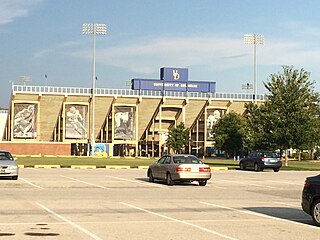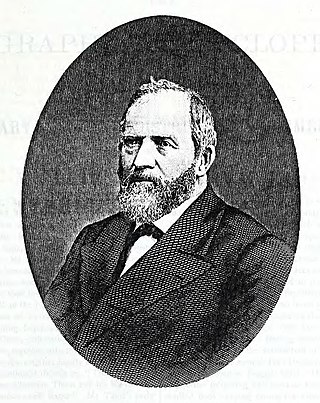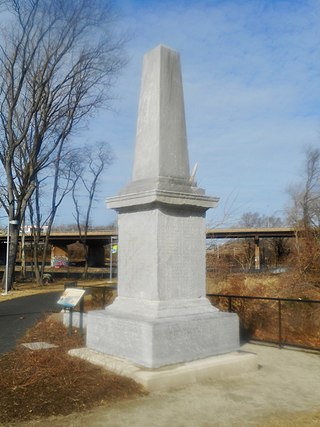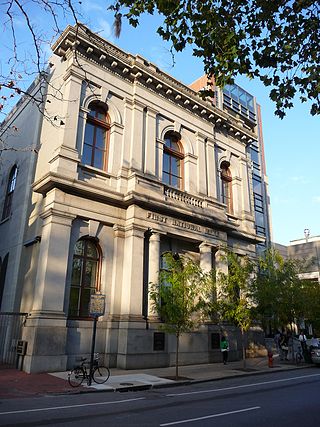Du Pont Motors was founded by E. Paul du Pont to produce marine engines for the Allied nations during World War I. After the war, Du Pont Motors produced extremely high-end automobiles. The cars were manufactured in Wilmington, Delaware.
The Transamerica Corporation is an American holding company for various life insurance companies and investment firms operating primarily in the United States, offering life and supplemental health insurance, investments, and retirement services. The company has major offices located in Baltimore, Maryland; Cedar Rapids, Iowa; Denver, Colorado; Norwood, Massachusetts; Exton, Pennsylvania; Harrison, New York; Johns Creek, Georgia; Plano, Texas; and St. Petersburg, Florida. Additional affiliated offices are located throughout the United States. In 1999, it became an independent subsidiary of multinational company Aegon.

George Fisher Baker was an American financier and philanthropist. Known as the "Dean of American Banking", he was also known for his taciturnity. Baker made a fortune after the Civil War in railroads and banking, and at his death was estimated to be the third richest man in the United States, after Henry Ford and John D. Rockefeller.

PNC Field is a 10,000-seat minor league baseball stadium that is located in Moosic, Pennsylvania in the Scranton/Wilkes-Barre metropolitan area that was built in 1989 and rebuilt in 2013. The stadium is home to the Scranton/Wilkes-Barre RailRiders, the Triple-A affiliate of the New York Yankees.

Momentum Bank Ballpark is a ballpark in Midland, Texas. It is primarily used for baseball, and is the home field of the Double-A Midland RockHounds minor league baseball team of the Texas League. Opened in 2002, the stadium holds 6,669 people with 4,709 fixed seats and the rest in berm seating.
Daniel S. Frawley Stadium is a stadium in Wilmington, Delaware. It is primarily used for baseball, and is the home field of the Wilmington Blue Rocks minor league baseball team. The park was originally known as Legends Stadium when it was built in 1993. It was renamed in 1994 for Wilmington mayor Daniel S. Frawley, who had pushed for a return of the Blue Rocks. The field is named separately for Judy Johnson, a local Negro league baseball star.

Delaware Stadium is a 22,000-seat multi-purpose stadium in Newark, Delaware, and is home to the University of Delaware Fightin' Blue Hens football team. The stadium is part of the David M. Nelson Athletic Complex, which includes the Bob Carpenter Center, Fred P. Rullo Stadium, the Fred Rust Ice Arena and the Delaware Field House.
Vermeer Technologies Incorporated was a software company founded in 1994 by Charles H. Ferguson and Randy Forgaard. Its products were a Web site development tool, FrontPage, and a Web server, Personal Web Server, which complemented developing in FrontPage. Vermeer launched the initial version of FrontPage on October 2, 1995.

Jacob Tome was an American banker, philanthropist, and politician who died as one of the richest men in the United States. He was the first millionaire of Cecil County, Maryland, and an accomplished philanthropist, giving money to colleges, churches, and schools, including establishing the Tome School.

The El Vernona Hotel–John Ringling Hotel was a famous hotel located at 111 North Tamiami Trail in Sarasota, Florida, United States.

Josiah Sleeper (18??–1946) was an American businessman who founded Sleeper's College in Chester, Pennsylvania, in 1910.

The Newkirk Viaduct Monument is a 15-foot white marble obelisk in the West Philadelphia neighborhood of Philadelphia, Pennsylvania. Installed in 1839, it is inscribed with the names of 51 railroad builders and executives, among other information.

The Chevrolet Series 490 is an early American automobile, made from 1915 to 1922 by Chevrolet. Introduced in June 1915, the 490 sold for $490. Chevrolet 490 was an immediate success and established the brand as a big player. The name would not denote the price for long, but it would stay low enough to take a chunk out of the Model T market. The Model T started at $495 at the time. Chevrolet was soon so profitable that Chevrolet owner Billy Durant began buying shares of GM stock with his Chevrolet stock, enough that he was able to take control of GM and merge Chevrolet with it. Electric horns were standard. And by 1921, standard equipment included a speedometer, and ammeter, dome lights, and headlight dimmers.

Matthew Newkirk (1794–1868), was a banker, railroad executive, and civic leader in Philadelphia, Pennsylvania. He was a director of the United States Bank, but he was best known as the president of the Philadelphia, Wilmington and Baltimore Railroad (PW&B), which in 1838 opened the first direct railroad link between Philadelphia and Baltimore, Maryland. He was also for many years the president of the Pennsylvania Temperance Society.

The Music City Center is a convention complex located in downtown Nashville, Tennessee, United States. It opened in May 2013.

First National Bank was a bank in Philadelphia. Chartered in 1863, it was the first national bank created under the Civil War banking reforms that began to define the modern U.S. banking system, and the first commercial bank to issue a federal banknote. It operated independently until 1955, when it was merged into the Bank of North America and Trust Company, today part of Wells Fargo.
James P. Stabler (1796–1840) was a chief engineer for two of the earliest railroads in the United States.

The World Trade Center Vehicle Security Center and Tour Bus Parking Facility, or simply the Vehicular Security Center (VSC), is a secure complex for truck delivery and underground parking at the World Trade Center in Manhattan, New York City. The entrance to the VSC is located at street-level along the southern edge of the National September 11 Memorial & Museum on Liberty Street. The VSC is connected via tunnels that feed the entire 16-acre (65,000 m2) WTC complex, linking the security checkpoint at its entrance with the buildings and services at the complex requiring vehicular services. Underground garages provide parking for tenants, visitors, and tour buses.
The Seneca Road Company was formed to improve the main road running west from Utica, New York, the Genesee Road, from Utica to Canandaigua and operate it as a toll road or turnpike. The road was originally laid out in 1794 from Baggs Square in downtown Utica at the ford of the Mohawk River and followed the Indian trail past Syracuse to Canandaigua. Some accounts say it went to Geneva and Avon originally. There was no City of Syracuse then. The road became known as the Seneca Turnpike, which was 157 miles (253 km) long and, at the time, the longest toll road in the state.